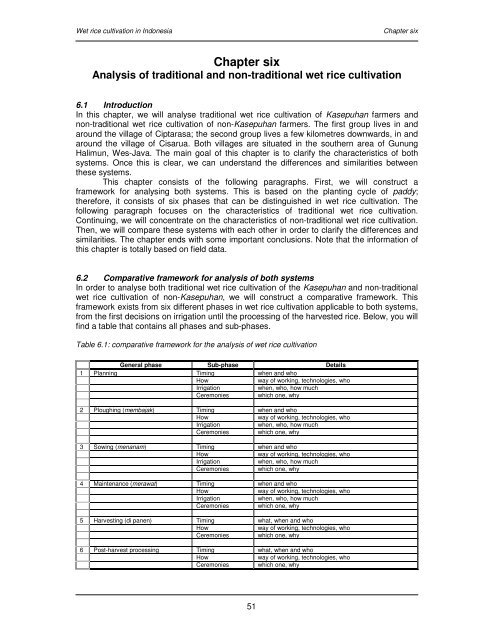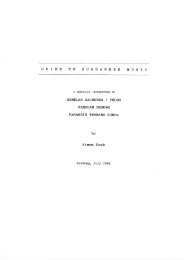Wet rice cultivation in Indonesia - Free EBooks Library
Wet rice cultivation in Indonesia - Free EBooks Library
Wet rice cultivation in Indonesia - Free EBooks Library
Create successful ePaper yourself
Turn your PDF publications into a flip-book with our unique Google optimized e-Paper software.
<strong>Wet</strong> <strong>rice</strong> <strong>cultivation</strong> <strong>in</strong> <strong>Indonesia</strong> Chapter six<br />
Chapter six<br />
Analysis of traditional and non-traditional wet <strong>rice</strong> <strong>cultivation</strong><br />
6.1 Introduction<br />
In this chapter, we will analyse traditional wet <strong>rice</strong> <strong>cultivation</strong> of Kasepuhan farmers and<br />
non-traditional wet <strong>rice</strong> <strong>cultivation</strong> of non-Kasepuhan farmers. The first group lives <strong>in</strong> and<br />
around the village of Ciptarasa; the second group lives a few kilometres downwards, <strong>in</strong> and<br />
around the village of Cisarua. Both villages are situated <strong>in</strong> the southern area of Gunung<br />
Halimun, Wes-Java. The ma<strong>in</strong> goal of this chapter is to clarify the characteristics of both<br />
systems. Once this is clear, we can understand the differences and similarities between<br />
these systems.<br />
This chapter consists of the follow<strong>in</strong>g paragraphs. First, we will construct a<br />
framework for analys<strong>in</strong>g both systems. This is based on the plant<strong>in</strong>g cycle of paddy;<br />
therefore, it consists of six phases that can be dist<strong>in</strong>guished <strong>in</strong> wet <strong>rice</strong> <strong>cultivation</strong>. The<br />
follow<strong>in</strong>g paragraph focuses on the characteristics of traditional wet <strong>rice</strong> <strong>cultivation</strong>.<br />
Cont<strong>in</strong>u<strong>in</strong>g, we will concentrate on the characteristics of non-traditional wet <strong>rice</strong> <strong>cultivation</strong>.<br />
Then, we will compare these systems with each other <strong>in</strong> order to clarify the differences and<br />
similarities. The chapter ends with some important conclusions. Note that the <strong>in</strong>formation of<br />
this chapter is totally based on field data.<br />
6.2 Comparative framework for analysis of both systems<br />
In order to analyse both traditional wet <strong>rice</strong> <strong>cultivation</strong> of the Kasepuhan and non-traditional<br />
wet <strong>rice</strong> <strong>cultivation</strong> of non-Kasepuhan, we will construct a comparative framework. This<br />
framework exists from six different phases <strong>in</strong> wet <strong>rice</strong> <strong>cultivation</strong> applicable to both systems,<br />
from the first decisions on irrigation until the process<strong>in</strong>g of the harvested <strong>rice</strong>. Below, you will<br />
f<strong>in</strong>d a table that conta<strong>in</strong>s all phases and sub-phases.<br />
Table 6.1: comparative framework for the analysis of wet <strong>rice</strong> <strong>cultivation</strong><br />
General phase Sub-phase Details<br />
1 Plann<strong>in</strong>g Tim<strong>in</strong>g when and who<br />
How way of work<strong>in</strong>g, technologies, who<br />
Irrigation when, who, how much<br />
Ceremonies which one, why<br />
2 Plough<strong>in</strong>g (membajak) Tim<strong>in</strong>g when and who<br />
How way of work<strong>in</strong>g, technologies, who<br />
Irrigation when, who, how much<br />
Ceremonies which one, why<br />
3 Sow<strong>in</strong>g (menanam) Tim<strong>in</strong>g when and who<br />
How way of work<strong>in</strong>g, technologies, who<br />
Irrigation when, who, how much<br />
Ceremonies which one, why<br />
4 Ma<strong>in</strong>tenance (merawat) Tim<strong>in</strong>g when and who<br />
How way of work<strong>in</strong>g, technologies, who<br />
Irrigation when, who, how much<br />
Ceremonies which one, why<br />
5 Harvest<strong>in</strong>g (di panen) Tim<strong>in</strong>g what, when and who<br />
How way of work<strong>in</strong>g, technologies, who<br />
Ceremonies which one, why<br />
6 Post-harvest process<strong>in</strong>g Tim<strong>in</strong>g what, when and who<br />
How way of work<strong>in</strong>g, technologies, who<br />
Ceremonies which one, why<br />
51








